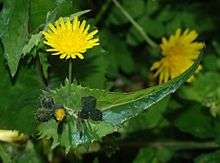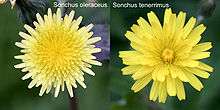Sonchus
Sonchus is a genus of flowering plants in the dandelion tribe within the sunflower family Asteraceae[2][4] and are commonly known as sow thistles (less commonly hare thistles or hare lettuces). Sowthistles are annual, biennial or perennial herbs, with or without rhizomes and a few are even woody (subgenus Dendrosonchus, restricted to the Canary Islands).[5][6][7][8][9]
| Sow thistles | |
|---|---|
 | |
| Sonchus oleraceus | |
| Scientific classification | |
| Kingdom: | Plantae |
| Clade: | Tracheophytes |
| Clade: | Angiosperms |
| Clade: | Eudicots |
| Clade: | Asterids |
| Order: | Asterales |
| Family: | Asteraceae |
| Subfamily: | Cichorioideae |
| Tribe: | Cichorieae |
| Subtribe: | Hyoseridinae |
| Genus: | Sonchus L. |
| Type species | |
| Sonchus oleraceus[1][2] | |
| Synonyms[3] | |
| |
Description
%2C_La_Gomera%2C_Espa%C3%B1a%2C_2012-12-14%2C_DD_01.jpg)
The genus is named after the Ancient Greek for such plants. All are characterized by soft, somewhat irregularly lobed leaves that clasp the stem and, at least initially, form a basal rosette. The stem contains a milky latex. Flower heads are yellow and range in size from half to one inch in diameter; the florets are all of ray type. Sonchus fruits are single-seeded, dry and indehiscent.[10] Sow thistles are common roadside plants, and while native to Eurasia and tropical Africa, they are found almost worldwide in temperate regions.[11]
Mature sow thistle stems can range from 30 cm to 2 m (1 to 6 ft) tall, depending upon species and growing conditions. Coloration ranges from green to purple in older plants. Sow thistles exude a milky latex when any part of the plant is cut or damaged, and it is from this fact that the plants obtained the common name, "sow thistle", as they were fed to lactating sows in the belief that milk production would increase. Sow thistles are known as "milk thistles" in some regions, although true milk thistles belong to the genus Silybum.
Invasive
In many areas sow thistles are considered noxious weeds,[12] as they grow quickly in a wide range of conditions and their wind-borne seeds allow them to spread rapidly. Sonchus arvensis, the perennial sow thistle, is considered the most economically detrimental, as it can crowd commercial crops, is a heavy consumer of nitrogen in soils, may deplete soil water of land left to fallow, and can regrow and sprout additional plants from its creeping roots. However, sow thistles are easily uprooted by hand, and their soft stems present little resistance to slashing or mowing.
Most livestock will readily devour sow thistle in preference to grass, and this lettuce-relative is edible and nutritious to humans—in fact this is the meaning of the second part of the Latin name of the common sow thistle, oleraceus.[13] Attempts at weed control by herbicidal use, to the neglect of other methods, may have led to a proliferation of these species in some environments.[14]
Cultivation
Sow thistles are common host plants for aphids. Gardeners may consider this a benefit or a curse; aphids may spread from sow thistle to other plants, but alternatively the sow thistle can encourage the growth of beneficial predators such as hoverflies. In this regard sow thistles make excellent sacrificial plants. Sonchus species are used as food plants by the larvae of some Lepidoptera including Celypha rufana and the broad-barred white, grey chi, nutmeg, and shark moths . The fly Tephritis formosa is known to attack the capitula of this plant.[15]

Sow thistles have been used as fodder, particularly for rabbits, hence the other common names of "hare thistle" or "hare lettuce". They are also edible to humans as a leaf vegetable; old leaves and stalks can be bitter but young leaves have a flavour similar to lettuce. Going by the name puha or rareke (raraki) it is frequently eaten in New Zealand as a vegetable, particularly by the native Māori. When cooked the flavour is reminiscent of chard
Species
Source:[3]
- Sonchus acaulis
- Sonchus adscendens
- Sonchus afromontanus
- Sonchus agrestis
- Sonchus amboinensis
- Sonchus andrenarum
- Sonchus angulatus
- Sonchus aquatilis
- Sonchus araraticus
- Sonchus arboreus
- Sonchus arvensis – field or perennial sow thistle
- Sonchus asper – spiny sow thistle, sharp-fringed sow thistle, prickly sow-thistle, or spiny-leaved sow thistle
- Sonchus bipontini
- Sonchus bornmuelleri – Bornmueller's sow-thistle
- Sonchus bourgeaui
- Sonchus brachylobus
- Sonchus brachylobus
- Sonchus brachyotus
- Sonchus brasiliensis
- Sonchus briquetianus
- Sonchus bupleuroides
- Sonchus camporum
- Sonchus canariensis
- Sonchus capensis
- Sonchus capillaris
- Sonchus cavanillesianus
- Sonchus cavanillesii
- Sonchus congestus
- Sonchus crassifolius
- Sonchus crepioides
- Sonchus crispus
- Sonchus daltonii
- Sonchus denticulato-lanceolata
- Sonchus denticulato-platyphylla
- Sonchus diffusus
- Sonchus dregeanus
- Sonchus dulosus
- Sonchus elongatus
- Sonchus eriopus
- Sonchus erythraeae
- Sonchus erythropappus
- Sonchus erzincanicus
- Sonchus esperanzae
- Sonchus fauces-orci
- Sonchus fragilis
- Sonchus friesii
- Sonchus fruticosus
- Sonchus gandogeri
- Sonchus gibbosus
- Sonchus gigas
- Sonchus gomerensis
- Sonchus gramineus
- Sonchus grandifolius
- Sonchus gummifer
- Sonchus haussknechtii
- Sonchus heterophyllus
- Sonchus hierrensis
- Sonchus hothae
- Sonchus hydrophilus[16]
- Sonchus hypochaeroides
- Sonchus integrifolius
- Sonchus intermedius
- Sonchus jacottetianus
- Sonchus jainii
- Sonchus kirkii – puha or rauriki
- Sonchus laciniatus
- Sonchus leptocephalus
- Sonchus lidii
- Sonchus lingianus
- Sonchus littoralis
- Sonchus luxurians
- Sonchus macrocarpus
- Sonchus maculigerus
- Sonchus malayanus
- Sonchus maritimus
- Sonchus masguindalii
- Sonchus mauritanicus
- Sonchus megalocarpa
- Sonchus melanolepis
- Sonchus microcarpus
- Sonchus microcephalus
- Sonchus monanthus
- Sonchus nanus
- Sonchus neglectus
- Sonchus nigricans
- Sonchus novae-zelandiae
- Sonchus novocastellanus
- Sonchus obtusilobus
- Sonchus obtusilobus
- Sonchus occidentalis
- Sonchus oleraceus – common sow thistle, smooth sow thistle, annual sow thistle
- Sonchus ortunoi
- Sonchus oxyspermus
- Sonchus palmensis – La Palma sow-thistle
- Sonchus palustris – marsh sowthistle
- Sonchus pendulus
- Sonchus pensylvanicus
- Sonchus perfoliatus
- Sonchus pinnatifidus
- Sonchus pinnatus
- Sonchus pitardii
- Sonchus platylepis
- Sonchus prudhommei
- Sonchus pustulatus
- Sonchus radicatus
- Sonchus regis-jubae
- Sonchus rokosensis
- Sonchus rotundilobus
- Sonchus saudensis
- Sonchus schweinfurthii
- Sonchus setosus
- Sonchus sosnowskyi
- Sonchus stenophyllus
- Sonchus subacaulis
- Sonchus suberosus
- Sonchus sventenii
- Sonchus tectifolius
- Sonchus tenax
- Sonchus tenerrimus[16] – slender sow thistle
- Sonchus tigridus
- Sonchus toletanus
- Sonchus transcaspicus
- Sonchus tuberifer
- Sonchus ustulatus
- Sonchus vaginatus
- Sonchus wightianus
- Sonchus webbii
- Sonchus wildpretii
- Sonchus wilmsii – milk thistle
- Sonchus yendoi
References
- Lectotype designated by N. L. Britton & A. Brown, Ill. Fl. N.U.S. ed. 2. 3: 316 (1913).
- "Sonchus L.". Tropicos. Missouri Botanical Garden.
- Flann, C (ed) 2009+ Global Compositae Checklist
- Linnaeus, Carl von. 1753. Species Plantarum 2: 793-795 in Latin
- For a recent review of woody species, see Seung-Chul Kim et al. (1996). "A common origin for woody Sonchus and five related genera in the Macaronesian islands: Molecular evidence for extensive radiation." Proceedings of the National Academy of Sciences USA, 93:7743-7748.
- Shi, Zhu; Kilian, Norbert. "Sonchus". Flora of China. 20–21 – via eFloras.org, Missouri Botanical Garden, St. Louis, MO & Harvard University Herbaria, Cambridge, MA.
- Altervista Flora Italiana genere Sonchus photos and distribution maps for several species
- Atlas of Living Australia
- Flora Zambesiaca
- R., Walters, Dirk (2006). Vascular plant taxonomy. Keil, David J., Murrell, Zack E. (5th ed.). Dubuque, IA: Kendall/Hunt Pub. Co. ISBN 0757512143. OCLC 62889410.
- Hyatt, Philip E. (2006). "Sonchus". In Flora of North America Editorial Committee (ed.). Flora of North America North of Mexico (FNA). 19. New York and Oxford – via eFloras.org, Missouri Botanical Garden, St. Louis, MO & Harvard University Herbaria, Cambridge, MA.
- "Sonchus arvensis". Natural Resources Conservation Service PLANTS Database. USDA.
- Arthur Lee Jacobson website Archived September 17, 2010, at the Wayback Machine
- Management of common sow thistle, Queensland Government
- White, I.M. (1984). Tephritid Flies (Diptera: Tephritidea). Handbooks for the Identification of British Insects. 10 pt 5a. Royal Entomological Society of London. pp. 134 pp. ISBN 0901546682.
- "Sonchus". Australian Plant Name Index (APNI), IBIS database. Centre for Plant Biodiversity Research, Australian Government, Canberra. Retrieved 2008-11-02.
External links
| Wikimedia Commons has media related to: |
- Everitt, J.H.; Lonard, R.L.; Little, C.R. (2007). Weeds in South Texas and Northern Mexico. Lubbock: Texas Tech University Press. ISBN 0-89672-614-2
- Low, Tim. Wild Herbs of Australia and New Zealand. Rev. ed. Angus and Robertson, 1991. ISBN 0-207-17001-0.
- Washington State Noxious Weed Control Board
- Perennial Sowthistle Fact-Sheet
- Botanical.com — sow-thistles
- Tamar Valley Weed Strategy SOW and PRICKLY SOW THISTLES